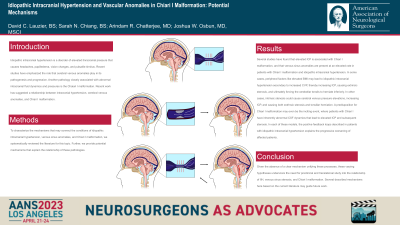Idiopathic Intracranial Hypertension and Vascular Anomalies in Chiari I Malformation: Potential Mechanisms
Friday, April 21, 2023


David C. Lauzier, n/a
Medical Student
Washington University School of Medicine
St. Louis, Missouri, United States
ePoster Presenter(s)
Introduction: Idiopathic intracranial hypertension is a disorder of elevated itnracranial pressure that causes headaches, papilledema, vision changes, and pulsatile tinnitus. Recent studies have emphasized the role that cerebral venous anomalies play in its pathogenesis and progression. Another pathology closely associated with abnormal intracranial fluid dynamics and pressures is the Chaiari I malformation. Recent work has suggested a relationship between intracranial hypertension, cerebral venous anomalies, and Chiari I malformation.
Methods: To characterize the mechanisms that may connect the conditions of idiopathic intracranial hypertension, venous sinus anomalies, and Chiari I malformation, we systematically reviewed the literature for this topic. Further, we provide potential mechanisms that explain the relationship of these pathologies.
Results: Several studies have found that elevated ICP is associated with Chiari I malformation, and that venous sinus anomalies are present at an elevated rate in patients with Chiari I malformation and idiopathic intracranial hypertension. In some cases, peripheral factors like elevated BMI may lead to idiopathic intracranial hypertension secondary to increased CVP, thereby increasing ICP, causing extrinsic stenosis, and ultimately forcing the cerebellar tonsils to herniate inferiorly. In other cases, intrinsic stenosis could cause cerebral venous pressure elevations, increasing ICP, and causing both extrinsic stenosis and tonsillar herniation. A predisposition for Chiari I malformation may even be the inciting event, where patients with Chiari I have inherently abnormal CSF dynamics that lead to elevated ICP and subsequent stenosis. In each of these models, the positive feedback loops described in patients with idiopathic intracranial hypertension explains the progressive worsening of affected patients.
Conclusion : Given the absence of a clear mechanism unifying these processes, these varying hypotheses underscore the need for preclinical and translational study into the relationship of IIH, venous sinus stenosis, and Chiari I malformation. Several described mechanisms here based on the current literature may guide future work.
Methods: To characterize the mechanisms that may connect the conditions of idiopathic intracranial hypertension, venous sinus anomalies, and Chiari I malformation, we systematically reviewed the literature for this topic. Further, we provide potential mechanisms that explain the relationship of these pathologies.
Results: Several studies have found that elevated ICP is associated with Chiari I malformation, and that venous sinus anomalies are present at an elevated rate in patients with Chiari I malformation and idiopathic intracranial hypertension. In some cases, peripheral factors like elevated BMI may lead to idiopathic intracranial hypertension secondary to increased CVP, thereby increasing ICP, causing extrinsic stenosis, and ultimately forcing the cerebellar tonsils to herniate inferiorly. In other cases, intrinsic stenosis could cause cerebral venous pressure elevations, increasing ICP, and causing both extrinsic stenosis and tonsillar herniation. A predisposition for Chiari I malformation may even be the inciting event, where patients with Chiari I have inherently abnormal CSF dynamics that lead to elevated ICP and subsequent stenosis. In each of these models, the positive feedback loops described in patients with idiopathic intracranial hypertension explains the progressive worsening of affected patients.
Conclusion : Given the absence of a clear mechanism unifying these processes, these varying hypotheses underscore the need for preclinical and translational study into the relationship of IIH, venous sinus stenosis, and Chiari I malformation. Several described mechanisms here based on the current literature may guide future work.
